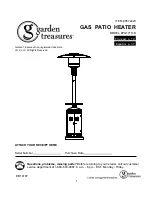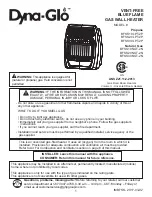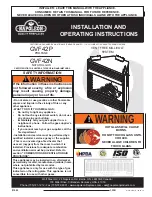
8
NOTE: 1. For water heaters in locations with high ambient
temperatures (above 100°F) and/or insufficient dilution air, it is
recommended that CPVC or ABS pipe and fittings be used. 2.
The SUPPLIED VENT TERMINAL must be used in all cases.
4. The temperature of the flue gases leaving the blower is about
160°F after mixing the dilution air in the inlet adapter of the
blower. Even with high concentrate of room air taken into the
vent system for dilution air, there will be some installations
where condensate will be formed in the horizontal runs of
the vent system. This condensate MUST NOT be allowed to
drain back into the fan unit.
One method to catch the condensate before it can run back
to the fan is to install a "TEE" mounted upside down and
capped, just past the first elbow, (Fig.9) of the vent pipe
system. This set-up will require the installation of a small (1/
4-3/8 inch) plastic tube, with the proper trap, to drain the
condensate to a floor drain.
A second method to prevent the condensate from draining
back to the fan unit would be to install the vent system with a
slight, 1/8 inch per five foot of pipe maximum, downward slope
(max. of 5/8 inch).
Number of
3" Maximum
4" Maximum
90° Elbows
Pipe (Feet)
Pipe Feet
ONE (1)
25
55
TWO (2)
20
50
THREE(3)
15
45
FOUR (4)
10
40
FIVE (5)
- - -
35
TABLE 1
INSTALLATION OF SIDEWALL VENT SYSTEM
Before beginning installation of piping system thoroughly read
the section of this manual VENT PIPE PREPARATION.
If you are installing your system so that it vents through roof,
please refer to following section titled INSTALLATION OF
VERTICAL VENT SYSTEM.
VENT TERMINAL INSTALLATION, SIDEWALL
1. Install the vent terminal by using the cover plate as a template
to mark the hole for the vent pipe to pass through the wall.
BEWARE OF CONCEALED WIRING AND PIPING INSIDE THE
WALL.
2. If the Vent Terminal is being installed on the outside of a
finished wall, it may be easier to mark both the inside and
outside wall. Align the holes by drilling a hole through the
center of the template from the inside through to the outside.
The template can now be positioned on the outside wall using
the drilled hole as a centering point for the template.
3. A) MASONRY SIDE WALLS
Chisel an opening approximately one half inch larger than
the marked circle.
B) WOODEN SIDE WALLS
Drill a pilot hole approximately one quarter inch outside of
the marked circle. This pilot hole is used as a starting point
for a saws-all or sabre saw blade. Cut around the marked
circle staying approximately one quarter inch outside of the
line. (This will allow the vent to easily slide through the
opening. The resulting gap will be covered up by the Vent
Terminal cover plate.) Repeat this step on inside wall if
necessary.
SEQUENCE OF INSTALLATIONS, FIGURE 4
Cut a length of 3" PVC pipe about 3.5 inches longer than the
wall thickness at the opening. Glue the vent terminal "TEE"
with screens to this section of pipe. Slide the wall plate over the
pipe to stop against "TEE". Place a bead of caulking (not
supplied) around the gap between the pipe and cover plate.
Apply enough to fill some of the gap between the pipe and wall.
Place some of the caulking on the back of the plate to hold it
against the wall after installation. If the vent pipe is installed up
to the wall, with a coupling on the end against the wall opening,
the pipe with the vent terminal can be prepared for gluing before
inserting through the wall. Slide the pipe through the wall and
insert into the coupling on the other side of the wall, making
sure that the vent terminal ends up pointed in the correct position.
(See fig. 5).
FIGURE 5
PREPARATION OF BLOWER ASSEMBLY
1. Check to make sure that the wire harness is attached to the
gas valve and blower control box..
2. Make sure no material is still attached to the outside or inside
of blower assembly.
FIGURE 6






































